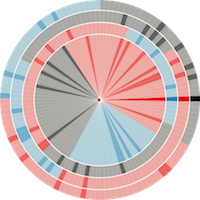Found 4 results for "starlight":
 862 862 | 2003 computer graphics by (unknown)
Starlight is a generic information visualization tool, developed by the Pacific Northwest National Laboratory (USA), that is applicable to a wide range of problems.
In these images, Starlight is being used as an assisting tool to uncover complex file systems. Many information resources are organized into hierarchical structures. Starlight's Hierarchy View can be used to explore the contents of extremely large categorical ontologies such as large, multipart documents, Web directories such as Yahoo, or, as shown here, large file directory structures.
The images show a Hierarchy View of a typical Microsoft Windows "Program Files" directory structure that was mapped out using the Starlight DirCrawler information harvesting utility. Provided with a starting directory, DirCrawler will navigate downwards through all constituent subdirectories, collecting file and directory property information as it goes. Once this process has been completed, the application outputs an XML file that can be used as input to Starlight. The directory structure shown below contains approximately 41,000 individual files organized into about 1400 discrete directories. The individual file glyphs have been color-encoded according to file extension, with image files colored green, text documents blue, computer programming-related files (e.g. source code) orange, etc. Executable files (.exe, .dll, etc.) are shown in yellow.
|
 868 868 | 2003 computer graphics by (unknown)
Starlight is a generic information visualization tool, developed by the Pacific Northwest National Laboratory (USA), that is applicable to a wide range of problems.
Computer network security has become an increasingly pressing issue for many organizations. Starlight can enable network analysts to quickly achieve and maintain an in-depth understanding of network vulnerabilities and security status.
The first image shows a Starlight Network View of computer NIDS data associated with an actual network intrusion incident. In this incident, several unauthorized users gained access to computers on official U.S. Government computer networks. In this example of "edge-oriented" network data visualization, individual NIDS log entries describing suspicious connections among computers are represented as edges in the display, with the nodes representing the individual computers (IP addresses) referenced in the data. This depiction portrays approximately 10,000 connections involving several hundred discrete IP addresses. The edges in this display have been color-encoded according to the "warning level" of the connection, with bright yellow indicating the most critical events. The second image is a closeup view of the suspicious connection (yellow line, left) shown in the preceeding image.
|
 863 863 | 2003 computer graphics by (unknown)
Starlight is a generic information visualization tool, developed by the Pacific Northwest National Laboratory (USA), that is applicable to a wide range of problems.
The first image shows a Starlight Network View representation of the "Information Visualization" Web community. This collection of Web pages was harvested using the Google search engine to retrieve the top 100 ranked pages containing the phrase "information visualization," as well as all pages that link to, or are linked to from, the pages in the query result set. The entire collection consists of approximately 1500 pages. In this view, nodes represent discrete Web pages, and edges represent hyperlink references among the pages. The pages are color-encoded according to their link class, with pages in the original result set colored green, result set inlinks colored blue, and result set outlinks colored yellow. Note that the majority of the result set pages are embedded in the clique (dodecahedra) and cluster (stellated dodecahedra) nodes.
The second image portraits the same Web page collection, now displayed as a Starlight Concept View. It shows conceptual correlations among the contents of the page text. Groups of conceptually related pages are shown displayed in the same cluster, and the clusters are arranged spatially such that clusters that are most similar are spatially adjacent.
|
 439 439 | computer graphics by John Risch and researchers at the Pacific Northwest National Laboratory
The system provide an immersive, fully 3D environment to display and analyse complex multimedia information collections and it was originally developed for US intelligence.
|

